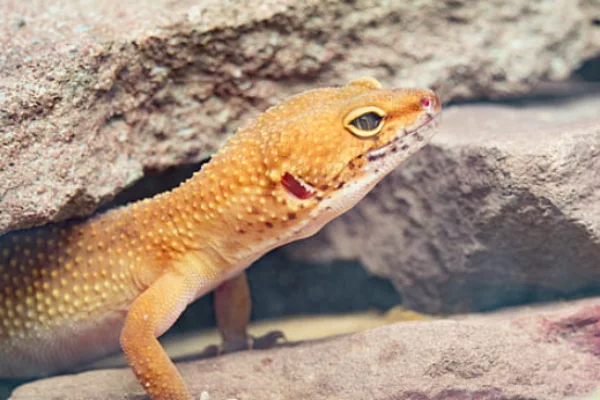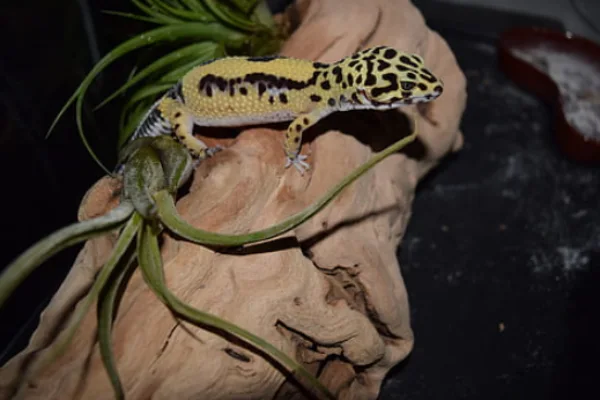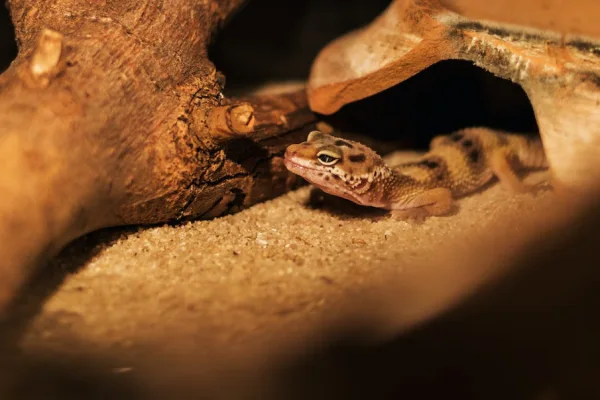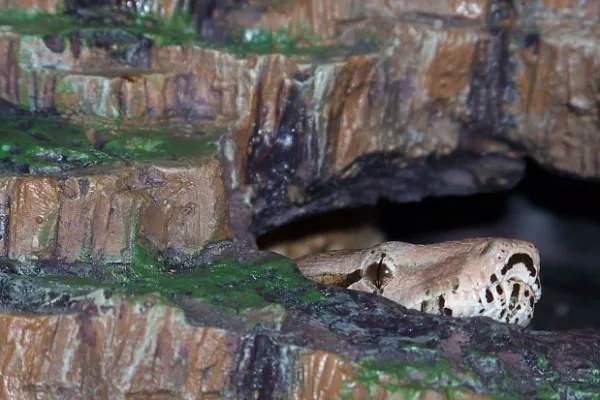Your friendly yet shy little pet gecko needs to feel at ease in your home. This creature prefers a rocky substrate to a sandy substrate and is almost always found on rocky outcroppings. This explains the need for apt Leopard Gecko Hides.
Neither you nor they should invade each other’s personal space. And for that reason, your adorable little friend needs a home in your home—a shelter, a hide!
Enhance Your Leopard Gecko’s Habitat with Proper Hides and Shelter!
The leopard gecko (Eublepharis macularius) is a ground-dwelling lizard that is indigenous to Afghanistan, Iran, Pakistan, India, and Nepal’s stony, dry grasslands and deserts.
Due to significant captive breeding, they have gained popularity as pets and are occasionally referred to as the first domesticated lizard species.
I. Significance of Leopard Gecko Hides

Let’s now get into why your pet gecko needs a hide and why making that choice requires careful consideration.
1. Security
The hides in your leopard gecko tank are a crucial component of their habitat since your gecko will seek refuge there from anything that scares it.
Any size, shape, or pattern of the hide is acceptable as long as it offers a sense of security, protection, and comfort for your gecko.
2. Thermoregulation
A temperature gradient is important so that your gecko can adjust his body temperature, keep comfortable, and go about his regular activities of eating, eliminating, and sleeping.
Too hot of a temperature might cause organ failure or dehydration. Respiratory infections or stomach problems may result from cold temperatures.
3. Molting
Humid hides are a crucial component of a habitat for leopard geckos. In nature, humid hides are basically humid caves that are necessary for self-regulation and shedding because they require more humidity then.
A moisture-retentive substrate (often Sphagnum moss), a cave-like structure (typically made of plastic), and occasionally a spray bottle to wet the substrate or cave are all the essentials to create a humid hide.
4. Rest and Sleep
Leopard geckos like to snooze in places where they feel safe from predators, such as under tree bark, in rock crevices, or among piles of leaves. Therefore, whether your pet gecko prefers to sleep during the day or at night, make sure it has a cozy, secure area to hide away.
II. Selecting the Right Leopard Gecko Hide

You’ll need three hides for your leopard gecko. One in the center, which will act as his humidity hide (helpful when shedding), one on the hot side, and one on the cold side of his tank.
1. Warm Hide
The warm side of the tank should have a warm hide where your leopard gecko can rest while raising its body temperature. This is because the warm hide will not only help them regulate their body temperature to their preference but also allow them to digest their food quicker and better.
2. Cool Hide
If the temperature within the tank is too high and geckos need a place to cool off, they stay on the cool side.
It’s also possible that they’re searching for the optimum area to spend the period of digestion because they don’t enjoy their warm hide or because they dislike it. Also, good heat conductivity and ventilation are seen in warm hides.
3. Moist Hide
Like many reptiles, leopard geckos are cold-blooded and rely on their surroundings to control their body temperature and level of hydration. Only a small portion of Leo’s hydration actually comes from drinking water; the majority comes from food and surroundings.
Now, just as Leopard Geckos must have the opportunity to drink whenever they feel like it, they must also have the option to hide in a damp cave if they require extra moisture for their skin and body.
4. Multiple Hides
Having many hides to give comfort to your small pet gecko is no harm. Depending on their needs at the time, they are free to stay wherever they see most appropriate.
III. Placing Leopard Gecko Hides Strategically

It takes more effort to create the optimal leopard gecko environment than to add a few rocks and a lightbulb to a tank.
To maintain their health and survival, these reptiles have very specific requirements that must be addressed.
1. Temperature Gradient
It is best to position the warm hide on the tank’s warmest side. It ought to be put on the heat mat to create a warm spot where your gecko can go to hide food or warm up if it’s too cold outside.
Your gecko should be able to go to a moist environment to soften their skin because it conceals both of their best qualities. When shedding, they will spend a lot of time here.
While half of the humid hide should be on your heat mat and the other half should be off.
Your warm hide should be on the side opposite your cool hide. This should be on the side of your tank that receives the most cooling air, giving your geckos a haven where they can cool off.
2. Accessibility
Attempt to avoid placing the tank in direct sunlight, which could lead to an overheated enclosure.
The best option is a screened, detachable top since it will provide the security you require, allow for proper ventilation and containment, and still shield your tiny friend from nosy children or house pets.
3. Variety
As was previously said, there must be many hides in the tank to guarantee that all of your pet’s needs are met. All three types of hides—moist, cool, and warm—are necessary at different times in your pet’s life cycle and in vital situations.
IV. Maintaining Leopard Gecko Hides

Keep your enclosure clean. Wash and sanitize the substrate and hide often. Whenever you handle your leopard gecko or clean its tank, wash your hands afterward.
It’s always best to divide this procedure into 3 essential steps as follows:
- Cleaning Routine
Create a consistent habit for both you and your pet that requires you to regularly clean their environment. And with appropriate caution.
- Substrate Check
Always confirm whether the substrate requires replacing. If you’re using disposable materials, it often requires change.
- Observation
If your gecko appears to be in any discomfort or distress, keep an eye on his behavior. That might be connected to how conscious they become due to their environment. It’s possible that you don’t want them to spend a lot of time in the hide. Make sure to look after it.
V. 10 Best Leopard Gecko Hides
1. Exo Terra Leopard Gecko Cave for Reptiles
This one fits nicely with tropical and desert terrariums. For reptiles and amphibians, that’s a place to rest which additionally assists in alleviating stress. By adding forest moss or Sphagnum moss to the cave, you can create a colder microclimate and dampness.
Amazon: Check this out
2. PENN-PLAX Reptology Shale Scape Step Ledge & Cave Hideout
This Shale Scape has a functional purpose in addition to being attractive. This item will be ideal for your pet reptile or amphibian if they enjoy climbing, since they may relax on the top basking platform while controlling their body temperature as desired.
Amazon: Check this out
3. Reptile Hides and Caves Birch Tree Bark Trunk Habitats
Curved hides are ideal for crawling reptiles. It offers the ideal spot for hiding, resting, playing, and breeding. It might make pets more secure. Your pet will feel at home in a natural setting thanks to the use of resin bark as tank décor for reptiles.
Amazon: Check this out
4. Kathson Gecko Coconut Husk Den
Made with durable coconut materials to ensure its longevity. Your small geckos will thrive in the Kathson Gecko House.
Amazon: Check this out
5. Fischuel Reptile Hides Humidification Cave
This one provides a safe enough place to hide and sleep soundly, avoiding harsh lights and being hidden from predators, keeping them vibrant by lowering stress.
This increases the air’s humidity inside the hide, and not throughout the tank. Aid in healthy skin shedding; your pet won’t get sick from the terrarium’s full damp atmosphere. The absence of any sharp edges reduces or eliminates the possibility of injuries.
Amazon: Check this out
6. Niteangel Natural Coconut Reptile Hideouts
This hide, which is made of real coconut, offers a safe hiding spot and relieves pressure. It can be used in dry or wet environments. Ideal decorative component for terrariums, giving it a natural appearance and increasing your pets’ appeal.
Amazon: Check this out
7. Black Reptile Habitat Box House Cave with Hollowed Out Design
Your gorgeous reptile pet will have a warm and cozy hiding place thanks to this habitat for reptiles. The edges of this hand-carved hideout are smooth and rounded which nullifies the chances of cuts and scratches, etc.
Amazon: Check this out
8. Zilla Rock Lair Small Hide
In this den, the solid top and side entry assists in controlling humidity. The heavy material also prevents the hide from moving. This hide’s rough outside texture, which aids animals in shedding skin, is one of its distinguishing characteristics.
Amazon: Check this out
9. Zilla Pet Reptile Terrarium Shale Rock Den
The hide, since it offers an elevated platform for your pet to bask and warm up, satisfies their need to locate a spot to hide and cool down. The exterior is non-porous, which prevents bacterial growth. Additionally, it is simple to clean by rinsing with warm, soapy water.
Amazon: Check this out
10. Dinosaur Skull Reptile Cave Habitat Hide
The foundation is highly stable thanks to the weight of this hide. It is purposeful since it permits climbing and hanging out in your pet’s daily life and is made of safe, non-toxic resin.
Amazon: Check this out
Conclusion
Owning a leopard gecko requires conscious effort and care because they are a shy and sensitive sort of lizard. Therefore, the owner must pay attention to the particular demands as they go through various stages and conditions in their lives. The first step is to assemble a suitable tank with a variety of hides.
Frequently Asked Questions
Q1. Does my pet gecko require multiple hides in its tank?
Ans. In order to provide your pet gecko with the comfort they require, it is usually preferable to install many hides in their tank. They might also feel as though they are living in a natural habitat as a result of this.
Q2. Is it common for a leopard gecko to spend most of his time inside his hide?
Ans. Your gecko is perfectly OK if it takes a bit longer to become used to its new home and family. Your pet may be spending a lot or most of his time hiding in the shelter for other reasons, though.
Q3. Are plastic hides safe for leopard geckos?
Ans. As long as the plastic is non-toxic, it is okay to use those plastic hides.
Q4. Can I use live plants in the hides?
Ans. Any plant that is safe and non-toxic is fine to use in the gecko terrarium as it will make the surrounding system a little more bioactive.
Q5. How many hides should I provide?
Ans. It’s recommended to provide at least 3 hides; a warm hide, a cool hide, and a moist hide.
Q6. What size hides are suitable for juvenile geckos?
Ans. One must set up a tank for long term and not just the juvenile phase of leopard gecko. Hence, a tank for an adult gecko must be at least 60 cm long, 40 cm tall, and 30 cm deep.
Q7. How often should I clean the hides?
Ans. The right answer is- as often as possible. And a full clean every 2-4 weeks or so.
Q8. Can I create DIY hides?
Ans. Yes, absolutely. The goal remains the same- providing best care environment to your pet gecko. Hence, setting up a DIY tank is a great idea if you do it correctly.
Also Read:

Anjali Prasad, a B. Pharm. graduate who works as a content writer for HowItSee, is based in Delhi. Except for her, not many people take the typical road from healthcare to writing. Her love of writing stemmed from her involvement in the college literature society and her early journaling at the age of 7. Hence, the love of learning and the spirit of exploration are what drew her to this career. You can find her on common social media like Instagram.
